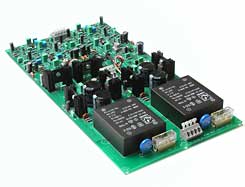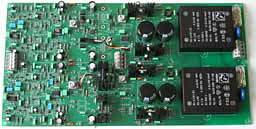Build directions
Click on the picture to get a larger view.
Before you build, take a look at possible component selections and trimming, also take a look at the error report. It doesn't harm to skip this but maybe it feels better in knowing to have a more symmetrical amp than you would have otherwise.
Have you noticed my method of naming the components? The reason why I did this is to limit the length och the parts name. A few components have number above one hundred. It's more difficult to get a clear marking on the pcb if the parts name is too long.
Left channel, right channel
R1 = E1 (resistors)
C1 = G1 (capacitors)
T1 = V1 (transistors)
Q1 = N1 (SMD transistors)
Y1 = U1 (SMD matched transistors)
MT = MT (Matched transistor pairs, the same in both channels)
The amp can be build in two different ways: The big bang method or the cautious method. It's nothing wrong with the big bang method if you are experienced and/or skilled.
The big bang method
Solder in everything and then apply voltage. If you are thorough, the amp works.
Recommended solder order (just for practical reasons). Start with low components and then take parts with bigger height. If you wait with the transistors you will have rather high caps as distances. This will make it much easier to solder in the transistors nice and straight.
- Transistors (SMD)
- Resistors
- Zeners
- Capacitors, plastic
- Capacitors, electrolytic
- Transistors (hole mounted)
- Transistors with heatsinks
- Regulators with heatsinks.
- Connectors
- Transformers
- Opamps, but wait until you have made the first test.
Error reports
Mixed up naming in the pcb but the schematic is correct.
E7 and E17 has switched positions at the pcb. The text "E7" and "E17" have been switched to be more exact. When I did the pcb I moved around the designators so they would be readable but in this case I messed it up.
Esthetic error in the pcb
The transistors Y9, N9 are slightly under E24, R24. Solder the transistors first.
The cautious method (recommended for most people)
Solder in all passive parts. Then solder some active parts and then test the function. If it's OK solder in more parts. This method is quite good if you have bought my rather expensive pcb's and want to have a nice looking result.
Recommended solder order
Recommended solder order (just for practical reasons). Start with low components and then take parts with bigger height.
- Resistors
- Zeners, match (if you want to) each pair DZ1 and DZ2, DZ3 and DZ4, DZ5 and DZ6, DZ7 and DZ8. The zeners should have the same value pairwise. Match them with same current as they will have in the circuit. Take 10 kohms in series and 15 or 18 volt.
- Capacitors, plastic
- Capacitors, electrolytic
- Connectors
- Transistors (hole mounted and/or SMD), see text below. Hole mounted transistors should have short legs, 5 mm is max. It's recommended to have a compact design. The transistors are more protected and the RF-rejection is improved (shorter antennas)
- Regulators with heatsinks.
- If you don't use DIL04 MOSFET's, mount heatsinks and power transistors.
- Transformers
- Opamps, but wait until you have made the first test.
Check one channel
Check one channel at the time. Start with the left channel. The building advice is for the left channel but the same goes for the right.
Solder first everything except for transistors and opamps. Wait also with the heatsinks for the power transistors but only if you not choose DIL04 MOSFET's. You can also solder all the components which are connected to the transistors in mind but it's no danger to solder all passive components first. Maybe it's easier to get an overview if not all passive components are in place.
Start to check one channel at the time. Note that you can apply voltage to one channel at the time.
VARNING THIS TEXT ABOUT CHECKING ISN'T READY YET!
- The transistors for the input stage. Start with T1-T26. Place a jumper at J1. The input will be more or less shorted. Apply voltage and measure the DC-voltages but bare in mind that the stage has a certain unbalance because it has no feedback.
- After that take T27-T36. Place a jumper at J1. The input will be more or less shorted. Apply voltage again and measure the DC-voltages. Now the amp has feedback but it should still have a minor unbalance, DC-voltage at the output. Up to 1 V at the output (TP1) can be expected.
- Check the range of the DC-servo. Apply 15V at pin 6 of IC1, and of course, no opamp in place. You should get a negative voltage at the output. Apply -15V at pin 6 of IC1. You should get a positive voltage at the output. If you don't get negative and positive output voltage you must lower the value R27, R28, R29 and R30. The DC-servo won't work otherwise. You must have symmetrical values of these resistors. R27 and R28 can have one value and R29 and R30 an other. Change the value in small steps. I think 68 kohms will cover all situations but it's less interfering with high values.
- Insert the IC1 opamp. Apply voltage. The output offset should be the same value as the opamp itself. < 0.5 mV is good but you set the limit for what it's good. I recommend that you don't use IC sockets and if you still want use high quality with "tulip" contact. I have used sockets only for development. Don't use them!
- Insert the IC5, chopper stabilized opamp for the input bias current servo amp. You can also use a slow low noise precision opamp but remember to remove the zeroing caps, C61, C62. If you use a normal opamp you don't need the zeners either, DZ9, DZ10.
- Check the servo. Apply J1. Apply voltage and have a voltmeter at the output, TP1. Remove the jumper and observe the output transient. After a while the output should be zero. This will take some time. If you test with a MC pickup (or a low resistance it will take minutes. The servo is necessary with super low noise transistors both with MM and MC pickup and with MM pickup with BCxxx transistors. With BCxxx and MC it's not a problem with base currents.
VARNING THIS TEXT ABOUT CHECKING ISN'T READY YET!
The whole pcb
Click on the picture to get a larger view.
The complete headphone amp with all components soldered in. The pcb has different looks left, right channel. The left channel has DIL04 MOSFET's and the right has bipolar power transistors on heatsinks. This is only for the picture taking.
The temperature sensing transistor
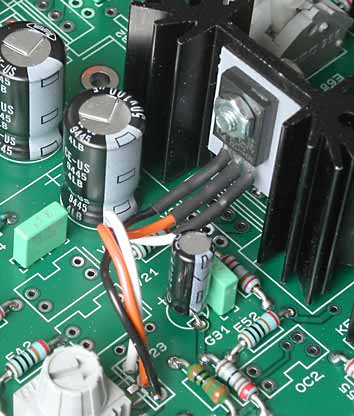
The picture shows how you should mount the temperature sensing transistor. Use isolation (I used silicone rubber) and isolate also the transistor pins with shrink tube.
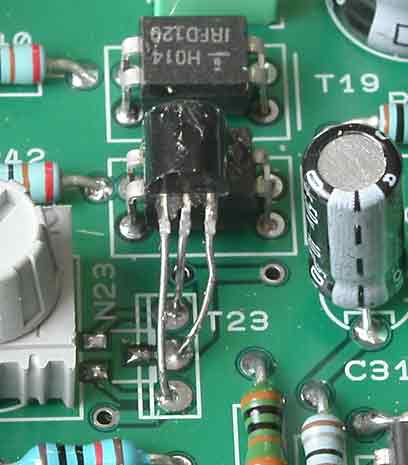
DIL04 mosfets with a temperature sensing transistor.
This picture shows how you should mount the temperature sensing transistor for the DIL04 MOSFET's. The transistor is glued with "contact glue", kontaktlim in swedish. I think almost any glue will do but it must withstand some heat. I used a bipolar transistor but you can also use a small signal MOSFET like for instance BS170 or similar. The advantage of having a MOSFET is that the idle current will be more constant when the amp is getting hotter. The advantage of using a bipolar is that the amp gets very temperature stable. This is not advisable in a normal power amp but in this case is quite OK because the amp works very much in class A regardless of load and signal level.
The tiny BC847BS and BC857BS in package SOT-363, the surface mounted matched transistor pair
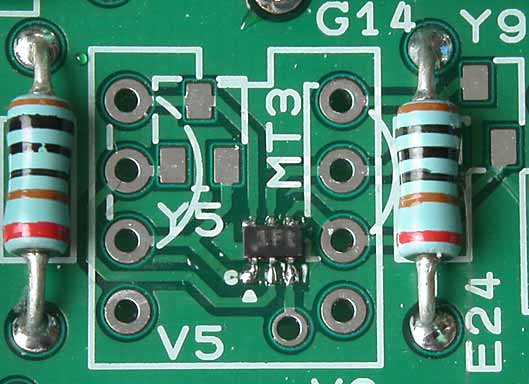
The tiny BC847BS and BC857BS in package SOT-363, the surface mounted matched transistor pair
This transistor is so small and it requires skills in soldring. This is not for a newbeginner. These transistors are really good compared to the price. You will get very small problems with temperature gradients but they are reduced heavily by the DC servos. It's not a big problem really. Beware of that this type has no noise parameters. They can be noisier than other types which has specified noise figures. In this particular design, the noise figure is not very important.
How small are the BC847BS and BC857BS? Click here.
If you want to use super macthed, ultra low noise transistors, you can use MAT02 and MAT03 but this is only interesting if you have higher gain. There is no need for it in a headphone amp. If you do use these transistors you must recalulate some resistor values in order to take advantage of the low noise properties.
Compensation capacitors
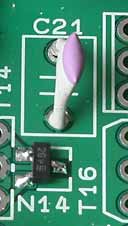
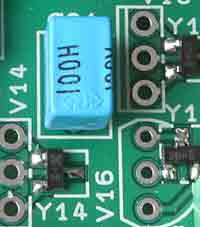
This part C20, C21, G20, G21, is rather sensitive when it comes to performance. You can either use a good NP0 ceramic capacitor or a polypropulene, the blue one. I'll guess other types will do, even silver mica!
Alternative smoothing capacitors
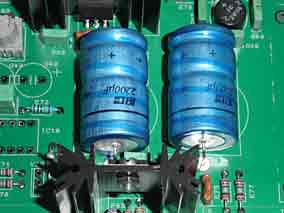
I have made an option for the smoothing caps. You can either choose axial caps like those in the picture or you can use radial ones. This is only a matter of taste and/or supply. Maybe it can be easier somewhere in the world to get axial capacitors.

